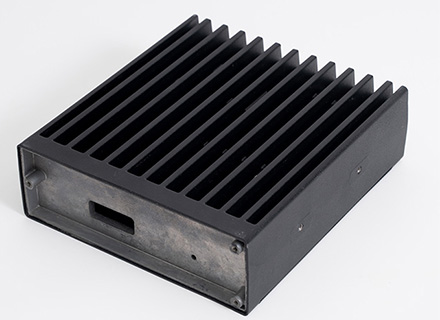A heat sink is an engineered thermal component designed to transfer heat from electronic or mechanical parts to the surrounding air or liquid environment, ensuring that devices operate below their maximum temperature limits. Commonly used in power electronics, LED lighting, communication equipment, and industrial automation systems, heat sinks play a vital role in maintaining performance stability, preventing overheating, and extending product lifespan.

Thermal Principle and Working Mechanism
The heat dissipation process of a heat sink involves three sequential stages:
Heat Conduction (Conduction Phase):
Heat is conducted from the heat source—such as a CPU, MOSFET, or LED junction—to the heat sink’s base through direct contact or thermal interface materials (TIMs). The efficiency depends on the thermal conductivity (λ) of the heat sink material, expressed in W/m·K.
Heat Spreading (Diffusion Phase):
Within the heat sink base, the heat spreads laterally before reaching the fins. The design of the base thickness and material homogeneity significantly impacts uniform heat distribution.
Heat Dissipation (Convection Phase):
Finally, the heat is released to the air through convection. The fins enlarge the surface area to accelerate heat exchange. In some cases, forced convection is applied using fans to increase airflow and improve the overall heat transfer coefficient (h).
The total heat transfer efficiency can be expressed as:
where
Q = heat transfer rate (W)
A = effective surface area (m²)
Tₛ = surface temperature (°C)
Tₐ = ambient temperature (°C)
Materials Used in Heat Sinks
(1) Aluminum Heat Sinks
Aluminum (Al) is the most widely used heat sink material due to its balance of thermal conductivity (~200–235 W/m·K), light weight, corrosion resistance, and ease of manufacturing. Common alloys include:
Aluminum heat sinks are often extruded, CNC machined, or die cast, and can be anodized into black heat sinks to increase emissivity and aesthetic value.
(2) Copper Heat Sinks
Copper provides excellent thermal conductivity (~385–400 W/m·K), nearly twice that of aluminum. It is preferred for high-power devices, LED floodlights, and CPU/GPU cooling modules. However, its high density (8.9 g/cm³) and processing difficulty increase cost and weight. Copper is often combined with aluminum in hybrid copper-aluminum heat sinks, achieving both performance and lightweight properties.
(3) Composite and Flexible Materials
Emerging technologies use graphite sheets, aluminum foam, or flexible polymer composites as flexible heat sink materials. These are used in thin devices, wearable electronics, and bendable LED panels. They offer moderate conductivity but exceptional flexibility and design freedom.
Structural Classifications and Features
Produced by forcing molten aluminum through a precision die, forming continuous extruded profiles with defined fin geometries. Advantages include:
High material utilization
Cost-effective for medium and large production runs
Length customizable (“cut to length heat sink”)
Fin spacing and thickness adjustable for specific airflow patterns
Common in LED lighting, amplifiers, and industrial controllers.
Manufactured by skiving (thin shaving) from a solid metal block, creating extremely thin fins (0.25–0.5 mm) with no bonding interface. This ensures excellent heat conduction from base to fin. Commonly used in high-power IGBT modules, server CPUs, and inverter power modules.
(3) Bonded Fin and Folded Fin Heat Sinks
Consist of individual aluminum or copper fins bonded to a base with solder or thermal epoxy. These designs allow for very dense fin arrays, ideal for forced-air or liquid cooling systems.
Bonded Fin Heat Sinks: Excellent for heavy-duty power systems.
Folded fin heat sinks: Use corrugated sheets to create lightweight, compact designs for portable electronics.
(4) Zipper Fin and Stamped Heat Sinks
Zipper fins are assembled from interlocked fin sheets, offering low thermal resistance and high strength-to-weight ratio. Stamped heat sinks are mass-produced from thin metal sheets, suited for consumer electronics where cost and size matter.
(5) CNC Machined Heat Sinks
Used for precision requirements such as aerospace, optical instruments, or semiconductor housings. CNC Machining ensures tight tolerance (<±0.02 mm) and supports complex shapes like cylindrical or circular heat sinks.
Design Parameters and Performance Optimization
A high-efficiency heat sink must consider both thermal and mechanical design parameters:
| Design Parameter | Technical Consideration | Effect on Performance |
|---|
| Fin Height & Thickness | Taller fins increase area but raise pressure drop | Balance between surface area and airflow |
| Fin Spacing | Too narrow → restricted airflow; too wide → less area | Optimized for airflow regime |
| Base Thickness | Thick base improves spreading but adds weight | Typically 2–6 mm for aluminum |
| Surface Treatment | Anodizing improves emissivity from 0.05 to 0.85 | Enhances radiation cooling |
| Mounting Method | Screws, clips, or adhesives affect contact resistance | Must ensure even pressure |
| Thermal Interface Material | Silicone pad, grease, or graphite film | Reduces interface thermal resistance |
Black anodized aluminum heat sinks are popular because black surfaces radiate heat more effectively due to their higher emissivity coefficient.
Manufacturing Processes
The manufacturing route depends on product size, precision, and thermal performance requirements:
Aluminum Extrusion: For standard heat sink profiles, cost-efficient and repeatable.
Die Casting: For complex shapes and enclosures, common in automotive electronics.
Skiving & Bonding: For high-performance and compact modules.
CNC Machining: For customized or low-volume parts.
Brazing and Welding: To assemble hybrid materials such as copper-aluminum structures.
All heat sinks undergo surface treatment, deburring, oxidation resistance testing, and dimensional inspection to ensure thermal and mechanical consistency.
Application Fields
LED Lighting: Circular or bar-type aluminum heat sinks dissipate heat from LED chips, preventing lumen degradation.
Power Electronics: High-power converters, rectifiers, and motor drivers use large bonded fin heat sinks.
Computing & Servers: CPU/GPU modules use skived or zipper fin copper heat sinks.
Renewable Energy: Solar inverters and battery packs require extruded aluminum cooling panels.
Telecommunication: Compact stamped aluminum heat sinks ensure efficient cooling in limited enclosures.
Future Trends
Next-generation heat sink development focuses on:
Graphene-enhanced aluminum composites with 40% higher conductivity.
3D-printed lattice heat sinks offering optimized airflow channels.
Phase-change integrated heat sinks for high-density chips.
Flexible polymer-metal hybrid heat sinks for wearable and foldable electronics.
These advancements aim to balance thermal performance, weight reduction, and manufacturing flexibility for evolving high-power and compact electronic systems.
From traditional extruded aluminum heat sinks to advanced composite fin structures, heat sink technology continues to evolve to meet the thermal demands of modern devices. Understanding the thermal conduction mechanism, material characteristics, and structural design principles is essential for engineers to select or design the optimal cooling solution. Whether for an LED module or an industrial inverter, a properly designed heat sink ensures not only thermal safety but also the reliability and longevity of the entire system.








